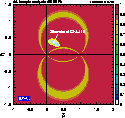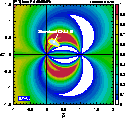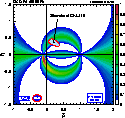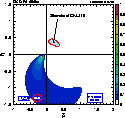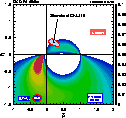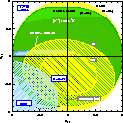CKM Constraints from Charmless B Decays:
Winter 2003
- # world average B --> pipi,Kpi branching fractions (BABAR, Belle and CLEO [1][2][3]).
# values of Cpipi and Spipi from BABAR and Belle.
the average of the two experiments is:
- Cpipi = -0.49 +- 0.19
- Spipi = -0.46 +- 0.26
- correlation = 0.058
- Chi2 = 7.2 (CL = 2.8%)
# for the standard CKM fit see the input page and hep-ph/0104062.
| Constraints on the branching fraction B0 --> pi0pi0 obtained from the measurements of B0 --> pi+pi-, B+ --> pi+pi0, B- --> pi-pi0 and Cpipi using the isospin relations (preprint). Given by the hatched area is the prediction from QCD FA: larger BR(B0 --> pi0pi0) require larger values of the unitarity triangle angle alpha/phi2. The upper plot uses Cpipi from BABAR, the lower plot uses Cpipi from Belle. The vertical arrow indicates the experimental upper limit at 90% CL found by BABAR. The horizontal arrows indicate the zone for which the CL is equal or better than 10%. |


|
